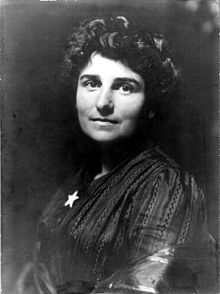Maud Ballington Booth
Maud Ballington Booth | |
|---|---|
 Maud Ballington Booth in 1902 | |
| Born | Maud Elizabeth Charlesworth 13 September 1865 Limpsfield, Surrey, U.K. |
| Died | 26 August 1948 (aged 82) Great Neck, New York, U.S. |
| Spouse | Ballington Booth |
| Relatives | Florence L. Barclay (sister) |
Maud Elizabeth Charlesworth (September 13, 1865 – August 26, 1948) later changed her name to Maud Ballington Booth, was a Salvation Army leader and co-founder of the Volunteers of America.[1]
Early life and education
[edit]Maude Charlesworth was born in Limpsfield, near Oxted, Surrey, England, the daughter of Rev. Samuel Charlesworth, an Anglican rector. One of three girls, she was a sister to bestselling romance novelist, Florence L. Barclay. When she was four, her father moved his family to Limehouse in London. The work of both her parents there in social issues led to Maud’s interest for social welfare and social service.
Career
[edit]In 1882, Charlesworth became a companion of Miss Catherine Booth in organizing a branch of the Salvation Army in Paris. In 1883, they went to Geneva, Switzerland, where they were both expelled after aggressive police interrogation.[2] She stayed with the Booth family and worked in the London slums and elsewhere until her marriage to the second son of the founder of the Salvation Army, Ballington Booth in 1886, against her father's wishes.[3] They had two children, Theodora and Charles.[4]
In 1887, she took command of the Salvation Army forces in the United States alongside her husband, Ballington Booth. She was also active and successful in slum mission work in New York City. In 1895, Booth became a naturalized American citizen.[5] She lived in Kew Gardens, Queens.[6]

In 1896, Ballington and Maud left the Salvation Army after a dispute with General Booth, to co-found the Volunteers of America.[7] Maud was also known for working to improve the conditions of prisons in the late 19th and early 20th centuries.[1] She later toured on the Chautauqua circuit, moving audiences with her vivid account of life in prisons and calls for reform. Among the other causes she embraced was the legalization of euthanasia.[8]
In 1918, she went to England and France to visit American troops in World War I.[9]
Selected works
[edit]- Branded (1897)
- Lights of Child-Land (1902)
- After Prison —What? (1903)[10]
- Twilight Fairy Tales (1906)
- "A Message from Mrs. Ballington Booth to the Volunteers of America" (1925)[11]
Later years
[edit]Booth's 75th birthday in 1940 was observed with celebrations in over 100 cities across the United States. She attended the event at New York City's Town Hall, which included messages from Franklin Delano Roosevelt and John J. Pershing on the occasion.[12] Her husband died in 1940, and she died in 1948, at the age of 82, at her daughter's home in Great Neck, New York.[4]
References
[edit]- ^ a b "Booth, Maud Ballington". Learningtogive.org. Archived from the original on July 28, 2005. Retrieved July 1, 2005.
- ^ Geneva Correspondent (19 February 1883). "A Lamb Among Wolves". The Times.
{{cite news}}:|author=has generic name (help) - ^ Maud Ballington Booth (1994). A Rector's Daughter in Victorian England. Volunteers of America. ISBN 1-885-287-01-1.
- ^ a b "Mrs. Maud Booth Dies at Age of 82; Co-Founder With Husband, the Late Ballington Booth, of the Volunteers of America". The New York Times. Retrieved 2023-07-26.
- ^ "Maud Ballington Booth | American religious leader". Encyclopedia Britannica. Retrieved 2018-02-19.
- ^ "Gift To Maud B. Booth.; Charles D. Stickney Leaves Residuary Estate to Head of Volunteers.", The New York Times, March 31, 1916. Accessed July 5, 2009. "Charles Dickinson Stickney, a prominent lawyer of this city, who died on March 8, did not provide in his will for twelve first cousins, two second cousins, and one aunt, but bequeathed his entire residuary estate to Mrs. Maud Booth, widow of Ballington Booth and head of the Volunteers of America, who lives in Kew Gardens, L.I."
- ^ "Booth, Maud Ballington - Social Welfare History Project". Social Welfare History Project. 2011-09-14. Retrieved 2018-02-19.
- ^ Appel, Jacob (2004). "A Duty to Kill? A Duty to Die? Rethinking the Euthanasia Controversy of 1906". Bulletin of the History of Medicine. 78 (3): 614. doi:10.1353/bhm.2004.0106. PMID 15356372. S2CID 24991992.
- ^ "Mrs. Maude Ballington Booth". Carry on. 4 (4): 22. November 1925.
- ^ Maud Ballington Booth (1903). After Prison - What?. Fleming H. Revell Company – via Project Gutenberg.
- ^ Ballington Booth, Mrs. (February 1926). "A Message from Mrs. Ballington Booth to the Volunteers of America". Carry on. 5 (1): 7.
- ^ World, Times Wide (1940-09-16). "Mrs. Booth Lauded on 75th Birthday; Pioneer in Prison Reform Is Recipient of Many Messages, One From President". The New York Times. ISSN 0362-4331. Retrieved 2023-07-26.
External links
[edit]- Works by Maud Ballington Booth at Project Gutenberg
- Works by or about Maud Ballington Booth at the Internet Archive
- Maud Ballington Booth at Find a Grave
- Maud Charlesworth (Mrs. Ballington) Booth From a scrapbook in the Carrie Chapman Catt Collection in the Rare Book and Special Collection Division at the Library of Congress
- Maud Ballington Booth, photograph; to speak in Geneva From a scrapbook in the Carrie Chapman Catt Collection in the Rare Book and Special Collection Division at the Library of Congress
- The Maud Ballington Booth Papers are housed at the University of Iowa Special Collections & University Archives.
- 1865 births
- 1948 deaths
- American Salvationists
- American activists
- People from Oxted
- English Salvationists
- English emigrants to the United States
- Burials at Ferncliff Cemetery
- 19th-century English writers
- 19th-century British women writers
- 20th-century English writers
- 20th-century British women writers
- People from Kew Gardens, Queens
